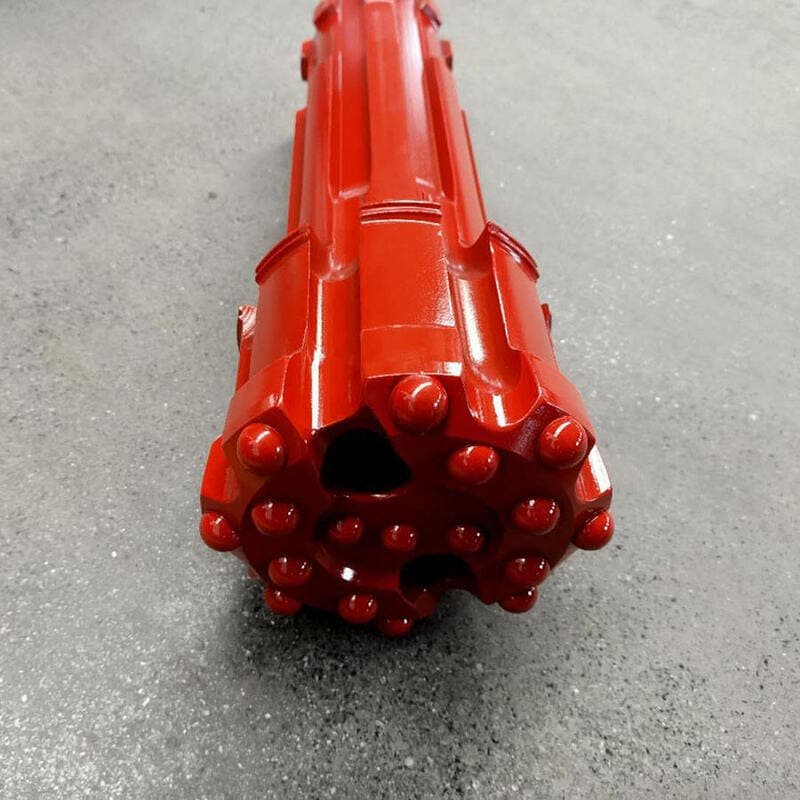Imagine having a tool that saves both time and money by lasting longer than expected.
High-quality Down-the-Hole (DTH) drill bits can last between 200 to 500 drilling hours. This depends on several factors, including the hardness of the rock being drilled, how the drill is operated, and the maintenance practices in place.
Think about it like this: When I first learned about the lifespan of these drill bits, I imagined how much hassle it would save if each bit lasted just a bit longer. Several factors can influence how long a DTH drill bit lasts, such as the type of rock you're dealing with or how you handle the equipment. Diving deeper into these details not only helps in prolonging the bit's life but also optimizes your entire project setup. It’s like making sure your car is serviced regularly – a little attention goes a long way!
DTH drill bits last over 500 drilling hours.False
High-quality DTH drill bits typically last between 200 to 500 hours.
Rock hardness affects DTH drill bit lifespan.True
Harder rocks can reduce the lifespan of DTH drill bits.
How Can You Extend the Lifespan of a DTH Drill Bit?
Understanding what affects a DTH drill bit's lifespan can be a real game-changer for anyone in the drilling business.
The lifespan of a DTH drill bit is impacted by factors like rock hardness, drilling parameters, flushing systems, bit design, and maintenance. By managing these aspects, you can prolong the bit's use, cut down costs, and boost drilling efficiency.

Geological Conditions
Imagine you're trying to break through a massive chunk of granite. That's what a DTH drill bit faces every day when tackling hard rocks. These tough conditions speed up wear and tear. In contrast, when I think of softer rocks like sandstone or limestone, it's like the drill bit gets a much-needed vacation, lasting longer due to reduced friction.
Drilling Parameters
I once learned the hard way that too much force can be more harmful than helpful. Just like how driving aggressively wears out your car faster, excessive pressure on a drill can prematurely wear it out. Striking a balance with moderate pressure and steady rotational speed keeps things running smoothly, much like cruising at a comfortable pace on a highway.
| Parameter | Optimal Setting |
|---|---|
| Drilling Pressure | Moderate to avoid overloading |
| Rotational Speed | Consistent for steady penetration |
Flushing System
I remember the first time I saw an efficient flushing system in action. It was like watching a maestro conduct an orchestra, ensuring everything stayed cool and debris-free. Adequate flushing pressure and volume are crucial here—just enough to keep temperatures down and the path clear of obstacles.
- Flushing Pressure: Adequate to maintain temperature.
- Flushing Volume: Sufficient to clear debris effectively.
Bit Type and Design
When picking a bit, it reminds me of choosing the right shoe for a hike. The right design can make all the difference—some bits are built for speed, while others are designed to last. Understanding your project's needs will help you pick the perfect fit.
Maintenance Practices
Regular maintenance is like giving your drill bits a spa day. It might seem tedious, but inspecting and replacing parts like shanks and flush holes can significantly extend their lifespan. Proper storage also plays a role—think of it as ensuring your gear is ready for action whenever you need it.
Drilling Technique
I can't stress enough how drilling technique impacts bit longevity. Maintaining consistent depth and avoiding overdrilling is key. Investing in training for operators ensures they handle the equipment with finesse, much like a seasoned chef with their favorite knife.
For more insights into these factors, exploring detailed guides on drilling parameters optimization1 and maintenance best practices2 can be incredibly helpful.
Harder rocks reduce DTH drill bit lifespan.True
Hard rocks increase friction, leading to faster wear of the bit.
Efficient flushing systems shorten bit lifespan.False
Efficient flushing prevents heat buildup, extending the bit's life.
How Does Rock Hardness Impact Drill Bit Durability?
I remember the first time I saw a drill bit crack under pressure—it was a lesson in rock hardness and durability.
Rock hardness directly impacts drill bit longevity by determining the rate of wear and tear. Harder rocks, like granite, create more friction and stress, leading to quicker wear than softer rocks, such as limestone.

Understanding Rock Hardness
When I first started working with drilling equipment, I had to learn about rock hardness the hard way—no pun intended. Rock hardness is essentially about how resistant a rock is to being scratched or dented. The Mohs scale is our go-to for this, rating rocks from soft, like limestone at 3-4, to hard, like granite at 6-7.
| Rock Type | Mohs Scale Rating |
|---|---|
| Granite | 6-7 |
| Basalt | 6 |
| Sandstone | 6-7 |
| Limestone | 3-4 |
Impact on Drill Bit Durability
I've seen the toll hard rocks take on drill bits firsthand. In harder conditions, a bit's life can shrink down to 200-300 hours. Softer materials, however, can stretch that life up to 400-500 hours. It's amazing how a seemingly small change in material can make such a difference.
Material Composition of Drill Bits
Not all drill bits are created equal. The first time I invested in high-quality carbide buttons3, it was a game-changer. Made with tungsten carbide, they handle stress much better, wearing down more slowly than cheaper alternatives.
Design and Maintenance
Bit design and upkeep are vital. Flat face designs tend to hold up better against abrasive conditions. Regular inspections and part replacements might seem tedious, but they can significantly boost a bit's lifespan4.
Operational Parameters
Operating parameters like rotational speed and feed rate are crucial too. I learned this from some costly mistakes early on—running at the right speeds can really extend the life of your bits even when you're up against tough conditions.
Understanding these factors has helped me make smarter decisions when selecting and maintaining drill bits across various geological conditions. It's an ongoing learning curve, but getting it right makes all the difference in efficiency and cost-saving.
Granite has a Mohs scale rating of 6-7.True
Granite is indeed rated between 6 and 7 on the Mohs scale, indicating high hardness.
Softer rocks extend drill bit durability to 600 hours.False
Softer rocks typically extend drill bit durability to 400-500 hours, not 600.
Why is Proper Maintenance Essential for Extending Drill Bit Life?
Ever wondered why your drill bits don't last as long as you'd like?
Regular maintenance of drill bits is crucial because it minimizes wear, prevents damage, and ensures optimal performance. By inspecting and caring for drill bits, you can extend their lifespan, reduce costs, and improve drilling efficiency.

The Role of Regular Inspections
One day, while tinkering around in my garage, I realized how much I'd been neglecting my trusty set of drill bits. It dawned on me that just like any other tool, these bits need some TLC. Regular inspection is key. I now make it a habit to check for wear and tear, chipping, or dullness after each project. A magnifying glass has become my go-to tool for spotting those tiny imperfections. Catching these early means I can sharpen5 or replace parts before they become a bigger problem.
Cleaning and Lubrication Practices
I'll never forget the time I spent hours drilling only to find out my bits were clogged with debris. Cleaning them thoroughly after each use has since become part of my routine. A good brush works wonders for getting rid of metal shavings and dirt. After cleaning, a light coat of oil keeps them rust-free and reduces friction the next time I'm drilling.
| Maintenance Task | Frequency | Tools Needed |
|---|---|---|
| Inspection | After every use | Magnifying glass |
| Cleaning | After every use | Brush, cloth |
| Lubrication | Weekly | Oil, rag |
Importance of Proper Storage
I used to toss my drill bits into a drawer without thinking twice. That was until I realized how much this affected their longevity. Now, I store them in a dedicated storage case6 in a dry spot, away from moisture and extreme temperatures. Labeling them by size and material has saved me countless headaches when selecting the right bit for the job.
Adapting Drilling Techniques
I've learned the hard way that technique matters as much as tool quality. Using proper alignment and pressure while drilling prevents undue stress on the bits. Once, I pushed too hard and ended up with a snapped bit mid-project! Since then, I've practiced patience and precision, often consulting with experts7 to refine my skills further.
Proper maintenance isn't just about prolonging the life of your drill bits—it's about making your work smoother and more efficient. These little practices have saved me time, money, and a lot of frustration in the long run.
Regular inspections prevent drill bit damage.True
Frequent checks help identify wear early, allowing timely maintenance.
Lubrication increases drill bit friction.False
Lubrication reduces friction, minimizing wear during drilling operations.
Conclusion
High-quality DTH drill bits typically last between 200 to 500 hours, influenced by rock hardness, drilling parameters, maintenance practices, and bit design.
-
Explore recommended settings to maximize bit life. ↩
-
Learn maintenance tips to extend drill bit longevity. ↩
-
Learn about carbide buttons and how they enhance drill bit durability against hard rock. ↩
-
Discover effective maintenance practices to prolong the lifespan of drill bits. ↩
-
Sharpening drill bits correctly restores cutting efficiency and prolongs their lifespan. ↩
-
Choosing a suitable storage case protects drill bits from damage and prolongs their usability. ↩
-
Learning advanced techniques from experts can optimize your drilling process and extend tool life. ↩








